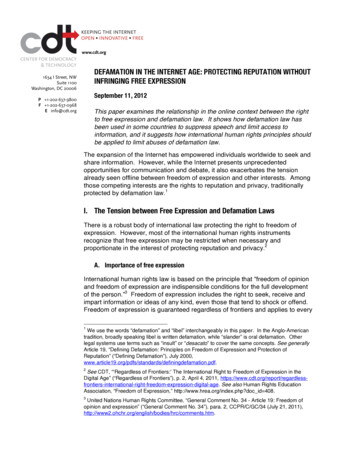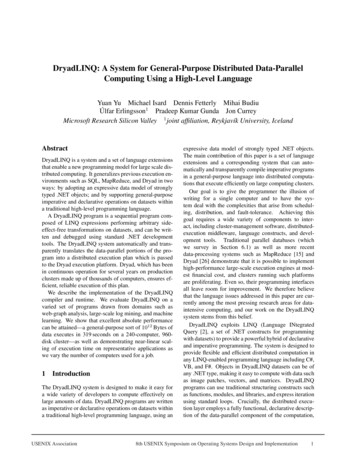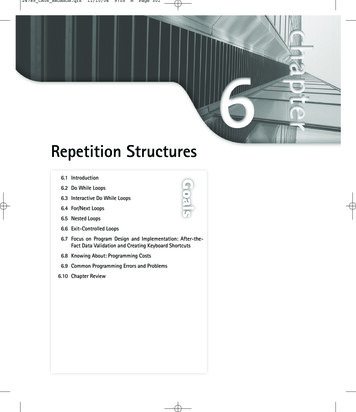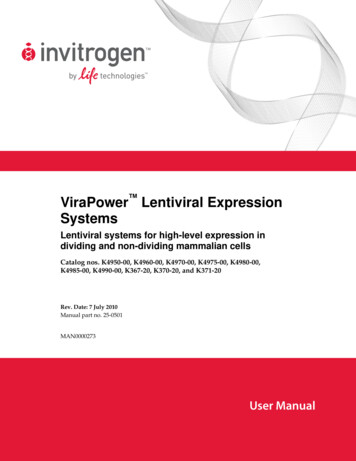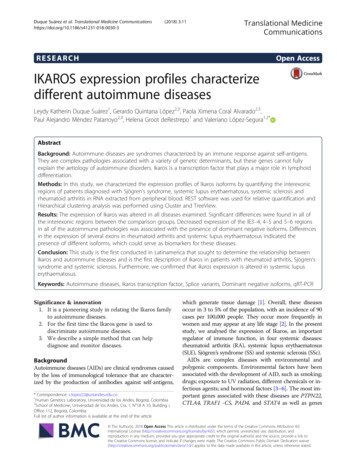
Transcription
Duque Suárez et al. Translational Medicine 030-3(2018) 3:11Translational MedicineCommunicationsRESEARCHOpen AccessIKAROS expression profiles characterizedifferent autoimmune diseasesLeydy Katherin Duque Suárez1, Gerardo Quintana López2,3, Paola Ximena Coral Alvarado2,3,Paul Alejandro Méndez Patarroyo2,3, Helena Groot deRestrepo1 and Valeriano López-Segura1,2*AbstractBackground: Autoimmune diseases are syndromes characterized by an immune response against self-antigens.They are complex pathologies associated with a variety of genetic determinants, but these genes cannot fullyexplain the aetiology of autoimmune disorders. Ikaros is a transcription factor that plays a major role in lymphoiddifferentiation.Methods: In this study, we characterized the expression profiles of Ikaros isoforms by quantifying the interexonicregions of patients diagnosed with Sjögren’s syndrome, systemic lupus erythaematosus, systemic sclerosis andrheumatoid arthritis in RNA extracted from peripheral blood. REST software was used for relative quantification andHierarchical clustering analysis was performed using Cluster and TreeView.Results: The expression of Ikaros was altered in all diseases examined. Significant differences were found in all ofthe interexonic regions between the comparison groups. Decreased expression of the IE3–4, 4–5 and 5–6 regionsin all of the autoimmune pathologies was associated with the presence of dominant negative isoforms. Differencesin the expression of several exons in rheumatoid arthritis and systemic lupus erythaematosus indicated thepresence of different isoforms, which could serve as biomarkers for these diseases.Conclusion: This study is the first conducted in Latinamerica that sought to determine the relationship betweenIkaros and autoimmune diseases and is the first description of Ikaros in patients with rheumatoid arthritis, Sjögren’ssyndrome and systemic sclerosis. Furthermore, we confirmed that Ikaros expression is altered in systemic lupuserythaematosus.Keywords: Autoimmune diseases, Ikaros transcription factor, Splice variants, Dominant negative isoforms, qRT-PCRSignificance & innovation1. It is a pioneering study in relating the Ikaros familyto autoimmune diseases.2. For the first time the Ikaros gene is used todiscriminate autoimmune diseases.3. We describe a simple method that can helpdiagnose and monitor diseases.BackgroundAutoimmune diseases (AIDs) are clinical syndromes causedby the loss of immunological tolerance that are characterized by the production of antibodies against self-antigens,* Correspondence: v.lopez22@uniandes.edu.co1Human Genetics Laboratory, Universidad de los Andes, Bogotá, Colombia2School of Medicine, Universidad de los Andes, Cra. 1, N 18 A 10, Building i,Office 112, Bogotá, ColombiaFull list of author information is available at the end of the articlewhich generate tissue damage [1]. Overall, these diseasesoccur in 3 to 5% of the population, with an incidence of 90cases per 100,000 people. They occur more frequently inwomen and may appear at any life stage [2]. In the presentstudy, we analysed the expression of Ikaros, an importantregulator of immune function, in four systemic diseases:rheumatoid arthritis (RA), systemic lupus erythaematosus(SLE), Sjögren’s syndrome (SS) and systemic sclerosis (SSc).AIDs are complex diseases with environmental andpolygenic components. Environmental factors have beenassociated with the development of AID, such as smoking;drugs; exposure to UV radiation, different chemicals or infectious agents; and hormonal factors [3–6]. The most important genes associated with these diseases are PTPN22,CTLA4, TRAF1 -C5, PAD4, and STAT4 as well as genes The Author(s). 2018 Open Access This article is distributed under the terms of the Creative Commons Attribution 4.0International License (http://creativecommons.org/licenses/by/4.0/), which permits unrestricted use, distribution, andreproduction in any medium, provided you give appropriate credit to the original author(s) and the source, provide a link tothe Creative Commons license, and indicate if changes were made. The Creative Commons Public Domain Dedication o/1.0/) applies to the data made available in this article, unless otherwise stated.
Duque Suárez et al. Translational Medicine Communications(2018) 3:11coding for HLA DR [7–9]. However, these genes cannotexplain the aetiology of all types of AID.Ikaros is the key member of a family of transcriptionfactors involved in lymphopoiesis. Ikaros is characterizedby two domains comprising highly conserved zinc fingers [10]. The first domain binds to specific DNA sequences depending on how many zinc fingers containsby alternative splicing [11]. The high level of alternativesplicing can generate multiple isoforms from each gene,including isoforms that arise from non-canonical splicing due to insertions and deletions [12–14]. Some ofthese, such as Ik6, act as dominant negative (DN) isoforms and have been associated with certain haematological pathologies [15–17]. These isoforms can kidnapfunctional isoforms (Ik1, Ik2, Ik3, etc.) in the cytoplasm,inhibiting their action on its target genes and thusrestricting their role as transcription factors [18].Ikaros plays a fundamental role in the differentiationof haematopoietic stem cells into lymphoid lineages [19],but, the relationships between the presence of dominantnegative isoforms and different types of haematologicalneoplasias have been described, suggesting that Ikarosplays an important role as a tumour supressor [20–22].The function of Ikaros in proper lymphocyte maturationand interferon production [23–25] clearly indicate that itcould play an important role in the origin of autoimmune diseases, as it does in the development of leukaemias. However, members of the Ikaros transcriptionfactor family are not currently used as susceptibilityand/or diagnostic markers because of their numerousisoforms and expression level variations as well as thetechnical difficulties associated with obtaining quantitative data. The correlations found in different studies between the overexpression of dominant negative isoformsand different types of leukaemias were determined usingRT-PCR, agarose gel electrophoresis and subsequentsequencing of fragments of interest [15, 16, 26–28]. Although these kinds of studies provide information aboutthe expression of specific isoforms, they cannot elucidatecomplete gene expression patterns for different types ofdiseases [29].Given the technical inability to obtain real quantitativedata for the expression levels of all Ikaros isoforms, a different protocol was used to characterize the expressionprofile of each interexon based on qRT-PCR. Though thismethod does not provide accurate information about eachisoform, qualitative changes in gene expression can be observed and associated with a profile, which can then belinked to a disease. The use of this technique in a previousstudy allowed different types of haematological malignancies to be distinguished, demonstrating that the expressionof Ikaros is disease-specific [21].In this study, we characterized the expression profilesof the exons of the Ikaros gene in Whole blood samplesPage 2 of 10from patients diagnosed with Sjögren’s syndrome, systemiclupus erythaematosus, systemic sclerosis and rheumatoidarthritis by qRT-PCR. This method could be of great diagnostic and monitoring value for these diseases.Material and methodsIndividuals and samplesOne hundred eighty individuals of both sexes who werediagnosed in the Rheumatology Department at the Hospital Fundación Santa Fe de Bogotá with rheumatoidarthritis (RA; 47), systemic lupus erythaematosus (SLE;26), systemic sclerosis (SSc; 43) or Sjögren’s syndrome(SS; 25) and were in the active stage of their disease wereincluded in this study. Thirty-nine healthy controlswere established in the same age range (Table 1). Weexcluded patients who had undergone organ transplantation (including bone marrow), had any type ofcancer, were pregnant or were diagnosed with otherautoimmune diseases.RNA extraction and cDNA synthesisPeripheral blood samples were taken after each patientsigned the informed consent form approved by the ethics committees at the Universidad de los Andes (Act No.176 approved under resolution No. 008430 of 1993 ofthe Ministry of Health). RNA extraction was performedusing whole blood, following the protocol of the manufacturer for the TRIzol reagent (Invitrogen). RNA quality andintegrity were analysed through quantification by spectrophotometry. Only samples with OD260/OD280 ratios between 1.8–2.0 were used for reverse transcription. cDNAwas synthesized from 1 μg of RNA following the protocolof the ImProm-II Reverse Transcription System (Promega).cDNA was quantified spectrophotometrically.Quantitative RT-PCR (qRT-PCR)Several Ikaros isoforms that were previously clonedinto plasmids and digested were used to standardizethe qRT-PCR method and to construct standardcurves. Appropriate efficiencies in the range of 90–110% (R2 0.996) were obtained using serial dilutions(25, 50, 100 and 200 ng) of these cloned isoforms toconfirm the reproducibility of our data.Table 1 Patients and controls included in this studyControlsRASLESSSScN3947262543Age 5%)25(100%)41(95.3%)RA rheumatoid arthritis, SSc systemic sclerosis, SLE systemic lupuserythaematosus, SS Sjögren’s syndrome
Duque Suárez et al. Translational Medicine Communications(2018) 3:11The efficiency of the qRT-PCR method was also monitored in every experiment using standard curves fromthe different PCRs randomly. This efficiency and the normalized gene values were calculated for each of theqRT-PCR assemblies. To assess the specificity of theprimers and the qRT-PCR method, we studied the meltingcurve of each amplicon with cloned material, whichproved that the qRT-PCR was specific (data not shown)[30, 31]. The glyceraldehyde 3-phosphate dehydrogenasegene (GAPDH) was used for normalization of theqRT-PCR data. The mean threshold cycle (Ct) for GAPDHwas 27.42 1.35, very robust data for an internal control.The PCRs were performed with primers designed ininterexonic region 2–3 (2F, 5′- GATCCCCGAGGACCTCTC-3′, and 3R, 5′- CGTAAATCCTCCGCACATTC-3′), interexon 3–4 (3F, 5′- TGTGATATCTGTGGGATCATTTG-3′, and 4R, 5′- GGAATGCAGCTTGATGTGC-3′), interexon 4–5 (4F, 5′- CCCTTCAAATGCCACCTCT-3′, and 5R, 5′- GCAGCGCTCTTTATGTTCCT-3′),interexon 5–6 (5F, 5′- GGCGACGTTACTTGCTAGTCT-3′, and 6R, 5’-GGCGACGTTACTTGCTAGTCT-3′)and interexon 6–7 (6F, 5’-AGCAAGTAACGTCGCCAAAC-3′, and 7R, 5′- CGTTGTTGATGGCTTGGTC-3′)(Fig. 1). We designed forward primers at the end and reverse primers at the beginning of each exon. Interexon 1–2 was not considered because no splicing variants havebeen reported in this region. The primers were designedbased on the Ikaros sequence BT009836.1 obtained fromthe National Center for Biotechnology Information(NCBI) GenBank database. Some of the primer parameters, such as the primer affinity for the target sequence,annealing temperature and specificity between pairs, wereassessed using the web program IDT SciTools PrimerQuest SM (www.idtdna.com).The experiments were conducted using a 7500 FastReal-Time PCR instrument (Applied Biosystems). Detection of the amplicons was evaluated with the PowerSYBR Green PCR Master Mix (Applied Biosystems).The standard protocol was conducted according to themanufacturer instructions as follows: activation of theenzyme at 95 C for 10 min and 40 cycles of denaturationat 95 C for 15 s and annealing and extension at 55 Cfor 1 min. The melting curve was standardized with thefollowing parameters: temperature range of 65–95 CPage 3 of 10with temperature increases in 0.5 C increments andmeasurements in 3-min intervals.Statistical analysisRelative quantitation and standardization was performedwith the software REST 2009 version 2.0.13, which is basedon the ΔΔCt method and incorporates the PCR efficiencyinformation [32, 33]. The patient samples were paired withcontrols by sex and age range. Statistical tests were conducted using the “R” statistical package version 3.3.1. Theassessment of data normality was determined with theShapiro-Wilk test, followed by the nonparametric methodsof Kruskal-Wallis and Dunn multiple comparison tests forexpression level comparisons. The Wilcoxon test was usedto compare the expression levels with patient sex. Interexon expression differences were determined to be significant at p-values less than 0.05.For the hierarchical clustering analysis, a logarithmic(base 2) transformation was performed for the expression and non-canonical splicing data, which were analysed with the Cluster 3.0 (Clustering Library 1.5)program using the following parameters: similarity measures, absolute correlation decentralized and completelinkage method. Java TreeView 1.1.6r2 software was usedto visualize the results.ResultsThe expression of Ikaros interexonic regions in AIDsWhen we analysed the expression of the Ikaros interexonicregions, significant differences were observed in regionsIE2–3 (x2 16.5; p 0.01), IE3–4 (x2 17.1; p 0.01), IE4–5(x2 32.8; p 0.0001) and IE6–7 (x2 30.8; p 0.0001). TheKruskal-Wallis analysis showed that there was a significantdifference between at least two groups of comparisonsin the expression level of each interexon, except forregion IE5–6.These results were confirmed by comparing each disease in pairs. The expression of IE2–3 was characteristicand significantly higher in RA patients compared to theother pathologies and controls (Fig. 2a). For IE3–4, individuals diagnosed with SLE had lower levels and individuals with RA had the highest expression levels of thisregion with respect to the controls and SLE and SS patients, and the differences were significant in both casesFig. 1 Diagram of the location of the primers and the amplified regions in each PCR. Each PCR was designed between the final part of thepreceding exon and the initial part of the next one. This design allows to avoid genomic contamination and also gives us information about thepresence of non-canonical splicings
Duque Suárez et al. Translational Medicine Communications(2018) 3:11Page 4 of 10Fig. 2 Expression level of every interexon (IK) in the assessed pathologies: inter-exon 2–3 (a), inter-exon 3–4 (b), inter-exon 4–5 (c), inter-exon 5–6(d) and inter-exon 6–7 (e). RA, rheumatoid arthritis; SSc, systemic sclerosis; SLE, systemic lupus erythaematosus; SS, Sjögren’s syndrome. * p 0.05,**p 0.01, ***p 0.001, ****p 0.0001(Fig. 2b). No difference was found between the RA andSSc individuals.For interexon 4–5, an important region for the DNAbinding domain (DBD), we observed a higher expressionlevel in the controls than in patients. This finding was related to the presence of DN isoforms with non-functionalDBDs. SS was the only disease that was not significantlydifferent from the controls (Fig. 2c).For interexonic region 5–6, similar expression levelswere observed between all of the disease groups and thecontrols, indicating that this region may not be involvedin these pathologies (Fig. 2d).
Duque Suárez et al. Translational Medicine Communications(2018) 3:11For interexon 6–7, we found higher expression levelsin individuals with RA and the lowest expression levelsin SLE patients compared with other pathologies andcontrols, and the differences were significant in bothcases (Fig. 2e), which may suggest that Ikaros has an altered the carboxyl terminus in patients with SLE thatcould affect its interaction with other proteins and/ortranscription factors.Detection of splicing variantsDetection of non-canonical splicing was performed bymelting curve dissociation. Unlike in leukaemias [21],non-canonical splicing was frequent in the AIDs examined (28% of the samples present non-canonical splicing). A curve of an interexonic region with two ormore peaks indicates the presence of different ampliconsor isoforms generated by non-canonical splicing, and wewould thus expect certain insertions or deletions. In allof the pathologies, there were cases that showed two melting peaks for interexons IE2–3, IE3–4, IE5–6 and IE6–7,indicating the presence of isoforms with splicing variantsfor all of the Ikaros exons. In addition, we detected threemelting peaks for IE2–3 in a patient with SS and for IE3–4 in 5 patients, 4 with RA and 1 with SSc, which suggeststhe existence of three possible isoform variants in theseregions (Fig. 3 and Additional file 1: Table S1).In rheumatoid arthritis and systemic Sclerosis patients, higher levels of isoforms (64.9%) generated bynon-canonical splicing were detected, with the majorityof the variants occurring in interexons IE2–3 and IE3–4(Fig. 3 and Additional file 1: Table S1). These variants involved exons encoding the DNA binding domain and, inFig. 3 Percentage of splicing variants detected in each exon. Mostof the samples present canonic splicing (72% of all splicing).However, there is a 26% of cases in which two peaks are found. Thisphenomenon, with the standardized technique, is associated withthe presence of non-canonical splicing. This percentage is especiallyimportant in the IE3-4, IE5-6 and IE6-7 regions. Triple peaks werealso detected in a total of 10 samples (Additional file 1: Table S1)Page 5 of 10the case of splicing between exons 6 and 7, exons inthe dimerization domain of the transcription factor, whichmay be relevant in these diseases.The control group individuals also had more than onepeak for all of the interexonic regions except for IE4–5,which mostly corresponded to IE2–3 (22 cases). Furthermore, three melting peaks were detected for IE3–4 in 4control individuals (Fig. 3 and Additional file 1: Table S1).These splice variants may result in functional Ikaros isoforms for those observed in the 2–3 region; conversely,the IE3–4, IE5–6 and IE6–7 variants could be susceptibility variants, but the individuals who harbour them maynot have developed a disease yet.Expression profile of each pathologyThe expression patterns of all of the Ikaros interexonswere analysed together for the pathologies and for thecontrol group. The control group had a very homogeneous profile with an equal proportion of expression foreach region, mainly reflecting the presence of completeand functional isoforms. (Fig. 4a).RA and SS patients had higher overall expressionlevels, which were accompanied by a higher proportionof DN isoforms. This presence of DN isoforms was especially important in RA, where a very characteristic profile was observed with exaggerated expression and thepresence of isoforms lacking regions IE3–4, IE4–5and IE5–6. Meanwhile, SLE and SSc individuals hadlower overall expression and a more balanced profile,with a minimum of DN isoforms. SLE patients hadthe greatest presence of functional isoforms, indicating that lack of Ikaros expression may be the possiblecause of this disease and not an imbalance of isoforms (Fig. 4a).For a complete profile of Ikaros expression, the patientsand controls were clustered, and the expression level ofeach interexonic region and the presence or absence ofnon-canonical splicing were considered. Although the disease groups could not be clearly differentiated from eachother, three clusters were apparent (Fig. 4b). The firstcluster comprised predominantly RA patients, who hadhigher expression levels of Ikaros and higher numbersof DN isoforms. The second group was characterizedby homogeneous expression and was composed of thecontrols and the SSc and SS patients. The final clustercontained SLE samples, which had lower expressionlevels of Ikaros (Fig. 4b).Expression levels of Ikaros interexonic regions accordingto sexGiven that autoimmune diseases are more common inwomen, we determined whether there were any differences between the expression levels of the distinct interexonic regions and the sex of the patients. The only
Duque Suárez et al. Translational Medicine Communications(2018) 3:11Page 6 of 10Fig. 4 Expression pattern and Hierarchical clustering of Ikaros in the assessed pathologies. (a) Expression pattern of Ikaros in the assessedpathologies: RA, rheumatoid arthritis; SSc, systemic sclerosis; SLE, systemic lupus erythaematosus; SS, Sjögren’s syndrome. (b) Hierarchicalclustering of Ikaros differential expression. Rows represent cases of RA, SLE, SS, SSc and controls, and columns refer to the log2 relative expressiondata and the absence or presence of non-canonical splicing. The expression levels are represented using a colour code with red and greencorresponding to high and low expression, respectively, and the intensity refers to the magnitude of the deviation from the mean. The presenceof non-canonical splicing is represented as “YES” and its absence as “NO”significant difference in expression levels between the controls and patients with autoimmune diseases was in theIE4–5 region, which showed low expression in men andwomen with AIDs (Fig. 5 and Additional file 2: Figure S2).The analysis by disease showed that expressionlevels were increased in men diagnosed with RAand SLE compared to women (Fig. 5a, b). The expression patterns of patients with SSc were similar,but women had higher expression levels. (Fig. 5c).The only significant differences in the expressionlevels according to sex were for IE2–3 in patientsdiagnosed with RA (p 0.003) and for IE5–6 in patients with SLE (p 0.026); no significant differenceswere found for individuals diagnosed with SSc. Thisanalysis was not possible for the patients with SS asall of these individuals were female.DiscussionThis study is the first in Latin America to determine therelationship between Ikaros and autoimmune diseasesusing a different methodological approach. The expression of Ikaros, almost exclusively in lymphoid line in theperipheral blood, makes any kind of purification unnecessary and facilitates the implementation of this technique in a simple and effective way. The technique inthe present study, which was standardized by Orozco etal. (2013) for haematological malignancies, showed thatthere were differences in the expression levels of Ikarosbetween individuals in the control group and those withdifferent AID pathologies. Moreover, these differenceswere not only in terms of overall expression but also included clear differences in the distribution of isoforms ineach of the diseases. These differences indicate that a
Duque Suárez et al. Translational Medicine Communications(2018) 3:11Page 7 of 10Fig. 5 Expression levels of Ikaros interexonic regions according to sex. Interexon expression in patients with rheumatoid arthritis (a), systemiclupus erythaematosus (b), and systemic sclerosis (c). The solid line shows the expression level without sex differentiation. F, female; M, male; RA,rheumatoid arthritis; SSc, systemic sclerosis; SLE, systemic lupus erythaematosusspecific Ikaros profile exists for each disease. Furtherstudies are needed to define the role of Ikaros as a causeor effect of disease development, but our data clearlyshow its value as a biomarker for some of these diseases(Fig. 2 and Additional file 3: Figure S1).In 2009, the Ikaros transcription factor was establishedas a new susceptibility gene for SLE through a GWASstudy (Genome-wide association study) in a Chinesepopulation, and it was identified as risk loci for Asian andCaucasian populations [34–39]. Before this study, therewas no indication of the relationship between the Ikarosfamily and these diseases, although its role in lymphoiddevelopment made the connection somewhat plausible.The methodology used in this study for the indirectquantification of isoforms has allowed us to corroboratealterations in the expression of Ikaros in SLE [40]. Inthis case, we not only confirmed that this disease ischaracterized by a low level of Ikaros expression but alsodemonstrated that, unlike other diseases, includinghaematological malignancies, there was not a significantpresence of dominant negative isoforms in SLE. Thisdifference may indicate that the molecular alteration isdifferent and is based on promoter regulation, whereasthe alternative splicing system seems to be altered inother diseases for reasons that are still unknown.For other autoimmune diseases such as RA, SS and SSc,no association with Ikaros have been reported; thus, ourstudy is the first to describe alterations in the expressionof Ikaros. At this point, it should be noted that greatdifferences were found in RA, and as IE3–4 or IE6–7 inSLE, the expression of IE2–3 or IE6–7 was sufficient todifferentiate these diseases from the other diseases andthe controls (Fig. 2 and Additional file 3: Figure S1).The study of the IE4–5 region is particularly interesting in both autoimmune diseases and haematological tumours. This region is essential in the Ikaros proteinstructure because exons 4 and 5 contain three of thefour zinc fingers motifs that comprise the DNA bindingdomain of the protein. For this reason, the lack of expression of this region is directly associated with thepresence of dominant negative isoforms of Ikaros. Theexpression of a dominant negative isoform was characterized in murine models in a study by Wojcik et al.(2009) in which Ik-7 (DN) led to lymphocyte deregulation even in presence of functional isoforms, such asIk-1 and Ik-3, resulting in a characteristic autoimmunedisease phenotype. In this case, the decreased functionof Ikaros and the presence of dominant negative isoforms on B cells did not result in leukaemia, likely dueto activation of the Notch signalling pathway, whichregulates T cell development and proliferation, in thepresence of reduced Ikaros activity [41].Our results showed a clear decrease in the expressionof the IE4–5 region in all of the diseases; however, theseresults must be analysed in conjunction with those ofthe remaining exons. Thus, only the RA samples showed
Duque Suárez et al. Translational Medicine Communications(2018) 3:11a clear presence of DN isoforms, while those of the SSand SSc patients were not substantially different from thecontrols. Conversely, the minimal expression of IE4–5 inindividuals with SLE was associated with a general lack ofexpression and not the presence of DN isoforms (Fig. 4).For the splicing variants, the two and three peak profiles detected in the IE2–3, IE3–4, IE5–6 and IE6–7 regions with the melting curve analysis indicated thepresence of different non-canonical isoforms involvingexons 3, 4 and 5 of the DNA binding domain, whichcould correspond to dominant negative isoforms (especially the IE3–4 variants). This non-canonical splicingcould due to insertions and/or deletions that result inisoforms already known, such as IK1 [13, 14], whichhas an insertion between exon 2 and 3, or IK1- [15],whose deletion at the 3′ end of exon 6 produces a truncated isoform. Moreover, variants in exons 6 and 7 couldaffect the domain that interacts with other proteins.In control group individuals, the detected IE2–3 variants may be functional isoforms, as is the case with thesingle nucleotide variant (SNV) that harbours a changeof G to T in position 501 (rs4917014) of the Ikaros DNAsequence and is considered a protector factor associatedwith IK-1 and IK-2 isoforms. The interaction ofrs4917014 with other SNVs is believed to counteract itsnegative effects, reducing the risk of SLE [42]. IE3–4 andIE5–6 variants could be susceptibility variants, but theindividuals who harbour them may not have developedan autoimmune disease yet or may not have demonstrated clear signs and symptoms of an AID yet. Theymay also correspond to SNVs that lead to non-germconstituent deletions of Ikaros exons 4 and 5, whichhave been previously reported in healthy populations[43], or Ikaros variants associated with other pathologiesthat have not been detected in these individuals, such asprimary immunodeficiencies characterized by hypogammaglobulinemia and decreased B cell counts [43, 44]. Inall of these cases, sequence-based studies that providemore detailed information about the insertions and/ordeletions that occur in these diseases is needed.Definitive conclusions could not be drawn regardinggene expression differences according to sex due to thelow proportion of men in this study. However, curiously,the profiles of RA and SLE were clearly defined by oneof the two sexes. For RA, men had profiles characterizedby the high expression and abundance of DN isoforms;in SLE, women demonstrated a lack of total Ikaros expression with the disease. These findings are importantbecause they indicate that including sex in any futurenomogram that contains Ikaros as a predictive value of adisease is critical.Although the role of Ikaros has been studied in cancerfor a long time, for autoimmune diseases, data regardingthe Aiolos gene are more prevalent. The deregulation ofPage 8 of 10Aiolos appears to cause autoimmune effects, which leadto the formation of autoreactive lymphocytes that candeleteriously affect the organism. Aiolos is normallyexpressed at high levels in mature B cells, and Aiolos-deficient adult mice developed glomerulonephritis mediated by immune complex formation in the kidney,which is characteristic of systemic lupus erythaematosus[45]. These mice had elevated serum levels of IgG andIgE, and their B lymphocytes exhibited surface markersthat indicate cellular activity and the spontaneous production of autoantibodies, such as anti-DNA, which arecommon in SLE [46].The importance of Aiolos and Helios in the development of AIDs necessitates their inclusion in expressionanalyses, which will provide more information on themolecular mechanisms of these diseases and allow betterdiscrimination between groups of pathologies, thus creating specific and complete expression profiles.ConclusionThis study is the first conducted in Latinamerica thatsought to determine the relationsh
Real-Time PCR instrument (Applied Biosystems). Detec-tion of the amplicons was evaluated with the Power SYBR Green PCR Master Mix (Applied Biosystems). The standard protocol was conducted according to the manufacturer instructions as follows: activation of the enzyme at 95 C for 10min and 40cycles of denaturation





